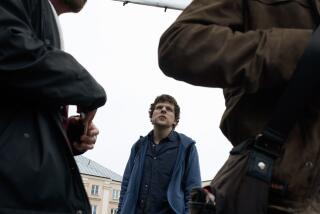For Gibson, Devil Is in the Details
WASHINGTON — Mel Gibson’s “The Passion of the Christ” may well be the best movie about Jesus Christ ever made. Yet, though he claimed to be striving for historical fidelity -- to the point of re-creating ancient Jerusalem in the southern Italian town of Matera and insisting that all dialogue be in Aramaic or Latin -- the film contains so many minor but distressing historical and linguistic inaccuracies that the overall effect is one of cognitive dissonance for anyone who has deeply studied the Roman and Near Eastern world of the 1st century. That includes me, although I am a medievalist by academic training.
I loved “The Passion,” but I wanted to love it even more.
Gibson retained the services of Loyola Marymount University priest-scholar William Fulco in preparing his Latin-Aramaic screenplay. But he didn’t consult more thoroughly with New Testament scholars who could have helped him craft a movie that would not only be the overwhelming Christian theological experience it is but also a more faithful evocation of Jesus’ 1st century world. He might have gotten right such significant details as the languages that Jesus and his contemporaries probably spoke, the clothes they wore and the mechanics of crucifixion.
That Gibson evidently didn’t seek more advice from academic professionals speaks volumes -- but not about Gibson. Rather, it’s an indictment of the ideological biases of most -- although by no means all -- New Testament scholars, who are determined to re-create a “historical” Jesus who has little to do with Christianity or the Gospels but has everything to do with the scholars’ pet philosophies and causes. These scholars, who invariably receive far more attention from the media than their more orthodox colleagues, include such talk-show regulars as John Dominic Crossan, former co-chair of the Jesus Seminar -- which maintains that Jesus said and did almost nothing the Gospels say he said and did -- and Boston University’s Paula Fredriksen, who argued in the New Republic last fall that not a single Jew, not even the corrupt high priest and Roman collaborator Caiaphas mentioned in the Gospels, had anything material to do with Jesus’ crucifixion.
Other scholars, operating from such redoubts of higher education as Columbia, Claremont and Toronto, have variously portrayed Jesus as a 1st century hippie, a political revolutionary, a gay-sex cultist, a practitioner of Cynic philosophy instead of Judaism and, a la Dan Brown in “The Da Vinci Code,” a rabbi who married Mary Magdalene and ran off to France. According to Robert Funk, founder of the Jesus Seminar, Jesus was a “secular sage” who had little use for religion. Crossan has famously speculated that Jesus’ body, far from rising from the dead on Easter as Christians have traditionally believed, was eaten by waiting wild dogs.
Since almost nothing is known about Jesus outside the New Testament, the main technique these scholars employ is a selective reading of the Gospels and the other New Testament writings that have shaped Christians’ understanding of Jesus. Humility is not one of these academics’ virtues; many of them not only insist that the Jesus they have reconstructed is the “real” Jesus, but they use their credentials to pull rank on ordinary Christians who maintain that the real Jesus is the one they find revealed in the documents of their faith. Not surprisingly then, many devout Christians -- including, apparently, Gibson -- have tended to ignore academic biblical scholars on principle, assuming they are all debunkers of the Bible.
Since earliest times, Jesus’ Passion, death and Resurrection -- not his virgin birth or his teachings or his healings, important as those might have been -- have been the center of Christian faith. “We proclaim Christ crucified,” wrote Paul of Tarsus perhaps 20 years after Jesus’ death.
The Gospel of Mark, perhaps the oldest of the four, devotes a full quarter of its brief narrative to Jesus’ last earthly days. That is because Christians believe that human evil is appalling and real, and that suffering and death are its price, but that Jesus, God’s son, willingly underwent every last stroke of human suffering in the world and the horror of death itself so that human beings might transcend death as Jesus did and enjoy eternal life.
Gibson got the theology right in “The Passion,” so why couldn’t he have gotten the historical details right too? Why did he insist that Jesus carry his entire cross to Calvary, when anyone who has read a bit of ancient history knows that condemned Roman prisoners carried only the crossbeam lashed to their shoulders, as the two thieves do in Gibson’s film? The soldiers fix the nails into Jesus’ hands in the middle of the palm (which would have torn away from the cross), not through the wrist bone as was more likely. And some characters in the film wear caricatures, not faithful reproductions, of ancient costumes -- such as the Temple guards, who dress like Orcs out of “The Lord of the Rings,” or the epicene, naked-to-the-waist Herod Antipas (Antipas was irreligious but also a canny and sensible politician).
It was fine for Gibson to have the Roman soldiers speaking Latin, for Roman legionaries had to be Roman citizens, which in Jesus’ time usually meant being born near Rome. But the soldiers, along with Pilate and his wife, don’t use the hard-consonant classical Latin pronunciation that prevailed during the 1st century. Rather, they use a softer medieval “church” Latin pronunciation that makes them sound like modern Italians. In fact, I swear that I heard a soldier in the movie shout, “Faccia!” (“Do it!”) in Italian, when the correct Latin would have been “fac” or “facias.” And if Gibson went to the trouble of commissioning a Latin-Aramaic screenplay, why didn’t he go all the way and capture the truly polyglot nature of ancient Judea, in which everyone’s second language was Greek, and Jerusalem at Passover would have been filled with Greek-speaking Jewish pilgrims from abroad?
These are all niggling mistakes, to be sure, but they come up constantly in “The Passion.” Furthermore, there are academics who combine sophisticated New Testament scholarship and genuine Christian faith and could have helped Gibson make a more persuasive film. To name a few: Luke Timothy Johnson, a Catholic; N.T. Wright, an Anglican; Ben Witherington, an evangelical Protestant. But their voices have been drowned out, leaving Gibson to follow his own misapprehensions about Jesus’ world, by the John Dominic Crossans who have managed to persuade us that faith and scholarship don’t go together.
More to Read
Only good movies
Get the Indie Focus newsletter, Mark Olsen's weekly guide to the world of cinema.
You may occasionally receive promotional content from the Los Angeles Times.










